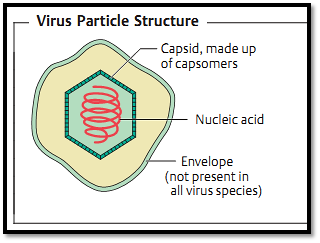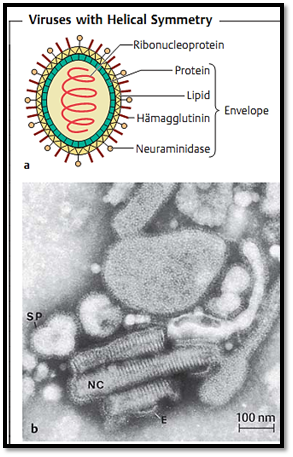


 النبات
النبات
 الحيوان
الحيوان
 الأحياء المجهرية
الأحياء المجهرية
 علم الأمراض
علم الأمراض
 التقانة الإحيائية
التقانة الإحيائية
 التقنية الحيوية المكروبية
التقنية الحيوية المكروبية
 التقنية الحياتية النانوية
التقنية الحياتية النانوية
 علم الأجنة
علم الأجنة
 الأحياء الجزيئي
الأحياء الجزيئي
 علم وظائف الأعضاء
علم وظائف الأعضاء
 الغدد
الغدد
 المضادات الحيوية
المضادات الحيوية|
Read More
Date: 2025-03-18
Date: 2025-01-30
Date: 19-11-2015
|
Morphology and Structure of virus
A mature virus particle is also known as a virion. It consists of either two or three basic components:
-A genome of DNA or RNA, double-stranded or single-stranded, linear or circular, and in some cases segmented. A single-stranded nucleic acid can have plus or minus polarity.
-The capsid, virus-coded proteins enclosing the nucleic acid of the virus and determining its antigenicity; the capsid can have a cubic (rotational), helical or complex symmetry and is made up of subunits called cap- somers.
-In some cases an envelope (Fig. 1) that surrounds the capsid and is always derived from cellular membranes.
Genome. The viral genome is either DNA or RNA, and viruses are hence categorized as DNA or RNA viruses. The nucleic acid of DNA viruses is usually double-stranded (ds) and linear or circular depending on the

Fig .1
family; the nucleic acid of RNA viruses is usually single-stranded (ss), with the exception of the reoviruses, and is also segmented in a number of virus families. Viruses with ssRNA are divided into two groups: if the RNA of the genome has the same polarity as the viral mRNA and can thus function directly as messenger RNA it is called a plus-strand (or positive-strand) or “sense” RNA strand and these viruses are sense or plus-strand viruses. If the genome RNA has the polarity opposite to that of the mRNA, and therefore cannot be translated into proteins until it has first been transcribed into a complementary strand, it is called a minus-strand (or negative-strand) or “antisense” RNA strand and the viruses are antisense or minus-strand viruses.
Capsid. The capsid (Fig. 1) is the “shell” of virus-coded protein that encloses the nucleic acid and is more or less closely associated with it. The combination of these two components is often termed the nucleocapsid, especially if they are closely associated as in the myxoviruses. The capsid is made up of subunits, the capsomers, the number of which varies but is specific and constant for each viral species. These are spherical or cylindrical structures composed of several polypeptides. The capsid protects the nucleic acid from degradation. In all except enveloped viruses, it is responsible for the attachment of the viruses to the host cell (“adsorption,” see the chapter on replication, p. 384) and determines specific viral antigenicity.
Envelope. The envelope (Fig. 1), which surrounds the capsid in several virus families, is always dependent on cellular membranes (nuclear or cell membrane, less frequently endoplasmic reticulum). Both cell-coded and viral proteins are integrated in the membrane when these elements are transformed into the envelope, frequently in the form of “spikes” (or peplomers, Fig. 2). Enveloped viruses do not adsorb to the host cell with the capsid, but rather with their envelope. Removing it with organic solvents or detergents reduces the infectivity of the viruses (“ether sensitivity”).

Fig. 2 a Schematic structure of a myxovirus. b Influenza viruses viewed with an electron microscope: The ribonucleoprotein spiral Envelope (nucleocapsid, NC) is visible inside the partially removed envelope (E). S = spikes.
Other Components of Viral Particles
Various enzymes. Viruses require a number of different enzymes depending on genome type and mode of infection. In several virus species enzymes are a component of the virus particle, for example the neuraminidase required for invasion and release of myxoviruses. Other examples include nucleic acid polymerases such as the RNA-dependent RNA polymerases in antisense viruses, the DNA polymerases in smallpox viruses and the RNA-dependent DNA polymerase (“reverse transcriptase”) in hepatitis B viruses and retroviruses.
Hemagglutinin. Some viruses (above all myxoviruses and paramyxoviruses) are capable of agglutinating various different human or animal erythrocytes. These viruses beara certain surface protein (hemagglutinin) in theirenvelope that enables them to do this. The hemagglutination phenomenon can be made use of for quantitative viral testing or—in the hemagglutination inhibition test—for virus identification and antibody identification. In biological terms, hemagglutinin plays a decisive role in adsorption and penetration of the virus into the host cell.
Structural Patterns
Cubic symmetry (rotational symmetry). Viruses with rotational symmetry are icosahedrons (polyhedrons with 20 equilateral triangular faces). The number of capsomers per virion varies from 32 to 252 and depends on the number of cap- somers (two to six) making up one side of the equilateral triangle. The capsomers in a virion need not all be the same, either in their morphology, antigen make-up or biological properties. Purified icosahedral viruses can be crystallized, so that images of them can be obtained using the methods of radiocrystallography. A number of virus images have been obtained with this method at a resolution of 2 A.
Helical symmetry. Helical symmetry is present when one axis of a capsid is longer than the other. The nucleic acid and capsid protein are closely associated in the ribonucleoprotein (RNP), in which the protein is tightly arrayed around the nucleic acid strand. This RNA-protein complex is known as the nucleocapsid, which takes the form of a helix inside the viral envelope. Fig. 7.3b shows this in influenza virus the envelope of which has been partly removed and Fig. 7.3a illustrates these symmetries schematically.
Complex symmetry. Complex structural patterns are found in bacteriophages and the smallpox virus (see Fig. 1, right). T bacteriophages, for example, have an icosahedral head containing the DNA and a tubelike tail through which the DNA is injected into the host cell.
References
Fritz H. Kayser, M.D. Emeritus Professor of Medical Microbiology Institute of Medical Microbiology, University of Zurich, Zurich, SwitzerlandThieme 2005, Stuttgart ! New York.



|
|
|
|
للعاملين في الليل.. حيلة صحية تجنبكم خطر هذا النوع من العمل
|
|
|
|
|
|
|
"ناسا" تحتفي برائد الفضاء السوفياتي يوري غاغارين
|
|
|
|
|
|
|
نحو شراكة وطنية متكاملة.. الأمين العام للعتبة الحسينية يبحث مع وكيل وزارة الخارجية آفاق التعاون المؤسسي
|
|
|